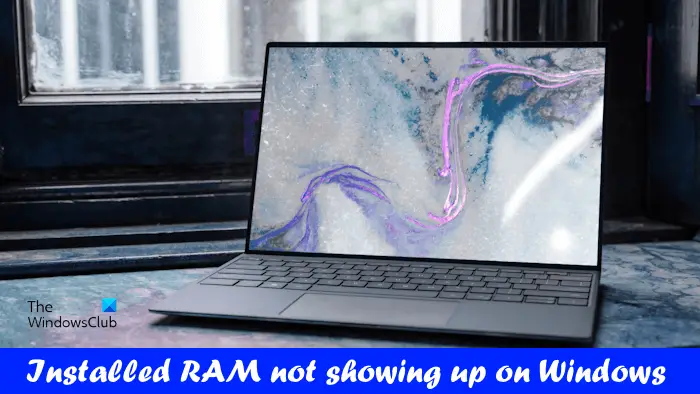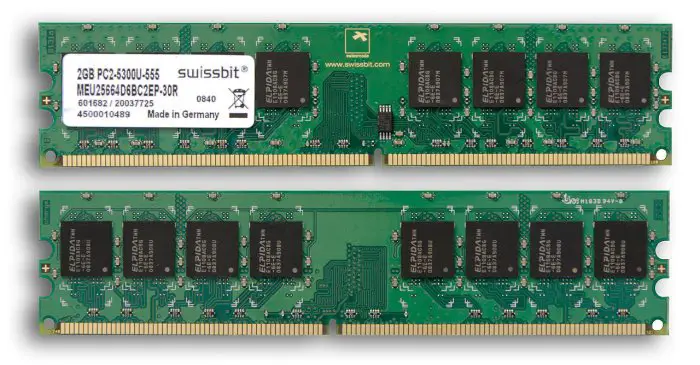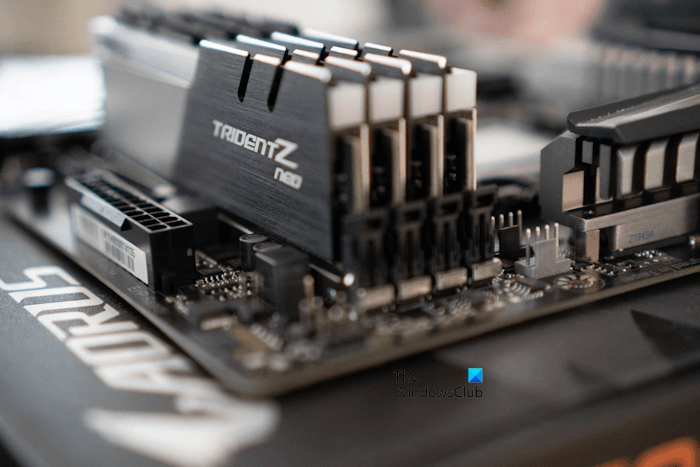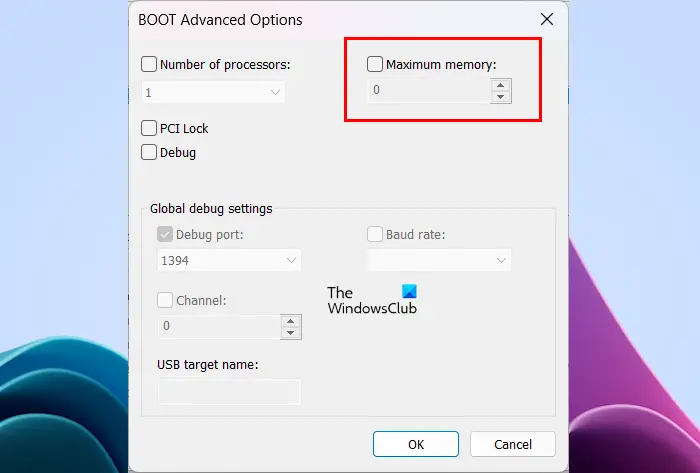Installed memory not showing up on Windows 11
If you have installed new RAM but it is not showing up on your Windows computer, this article will help you solve the problem. Usually, we improve the performance of the system by upgrading RAM. However, system performance also depends on other hardware such as CPU, SSD, etc. Upgrading RAM can also improve your gaming experience. Some users have noticed that installed memory is not showing up in Windows 11/10. If this happens to you, you can use the advice provided here.

Installed memory not showing up on Windows 11
If the installed RAM is not showing up on your Windows 11/10 PC, the following suggestions will help you.
Below, we have explained all these fixes in detail.
1] Is the installed RAM compatible with your computer motherboard?
When purchasing new memory, the most important factor that users must consider is memory compatibility. The new RAM must be compatible with the motherboard, otherwise it cannot be installed and used properly. To ensure you choose the correct memory module, you can visit the motherboard manufacturer's official website to find compatible RAM models. This can avoid system stability problems caused by incompatibility and ensure the smooth installation and operation of the memory.

If the memory modules you purchased are not compatible with the motherboard, you will need to replace them.
2] Check memory status in BIOS
You can confirm whether the installed memory module is recognized by checking the computer's BIOS. Enter the BIOS interface and check the display of installed memory. If the BIOS successfully displays the installed memory, then you may need to try other methods to resolve the issue.
If the BIOS fails to detect the memory module (S), the memory module (S) may be faulty. However, we recommend trying all other possible fixes before jumping to conclusions.

Different brands of computers have different dedicated keys to enter BIOS settings. Visit your computer manufacturer's official website to learn the correct key to enter BIOS setup. After entering your computer's BIOS, look for System Information to view memory information.
3]Reseat the memory

Make sure all memory modules are properly seated. Problems may occur if the RAM is not installed correctly. Therefore, we recommend that you remove all memory modules and install them correctly. Before installing a memory module, clean the memory module and memory slots because dust and debris inside the memory slots can sometimes prevent the computer from detecting the memory module.
4]Install the memory modules in the correct order
Each motherboard has different RAM installation configurations. Proper configuration should be followed when installing RAM. Otherwise, your computer will not recognize the installed memory module. For example, if you only have two RAM sticks, but your computer motherboard has 4 RAM slots, the RAM sticks should be installed in some specific RAM slots so that your computer can detect them.
This information can be found in the user manual for your computer's motherboard. Refer to your computer's motherboard's user manual for the correct order for installing RAM.
5]Check memory limit
In Windows computers, you can limit memory. If this limit is activated on your computer, it will only detect the maximum RAM specified in the memory limit. Follow the instructions mentioned below to check:

After completing the above steps, restart your computer. This time the issue should be resolved.
6]Update or reset BIOS

We also recommend that you update your BIOS to the latest version or reset BIOS settings to default. To update your BIOS to the latest version, you can download the latest version from your computer manufacturer's official website and then run the installer file with administrative rights.
7]The memory may be faulty
If your computer still does not recognize the memory module(s) despite trying all of the above fixes, the memory module(s) may be faulty. You can check this by installing a RAM Stick on another compatible computer motherboard (if you have one). If the memory is faulty, replace it.
that's all.
Why are only 8 GB of 16 GB RAM available in Windows 11?
The most common cause of this problem is memory limitations. If memory throttling is activated on your system, it will not detect all memory modules installed on your computer. You can check this in MSCONFIG's advanced options. Another cause of this problem is faulty memory module(s). However, if your memory stick is new, failure is less likely.
How to fix free memory on Windows 11?
If you have less RAM available on your system, close any unnecessary applications running in the background. You can view memory-hogging programs in Task Manager. If you don't use them, turn them off. Clearing the memory cache also helps reduce memory usage on Windows PC.
Read next: Fix Wrong RAM Speed on Windows.
The above is the detailed content of Installed memory not showing up on Windows 11. For more information, please follow other related articles on the PHP Chinese website!

Hot AI Tools

Undresser.AI Undress
AI-powered app for creating realistic nude photos

AI Clothes Remover
Online AI tool for removing clothes from photos.

Undress AI Tool
Undress images for free

Clothoff.io
AI clothes remover

Video Face Swap
Swap faces in any video effortlessly with our completely free AI face swap tool!

Hot Article

Hot Tools

Notepad++7.3.1
Easy-to-use and free code editor

SublimeText3 Chinese version
Chinese version, very easy to use

Zend Studio 13.0.1
Powerful PHP integrated development environment

Dreamweaver CS6
Visual web development tools

SublimeText3 Mac version
God-level code editing software (SublimeText3)

Hot Topics
 Can I install mysql on Windows 7
Apr 08, 2025 pm 03:21 PM
Can I install mysql on Windows 7
Apr 08, 2025 pm 03:21 PM
Yes, MySQL can be installed on Windows 7, and although Microsoft has stopped supporting Windows 7, MySQL is still compatible with it. However, the following points should be noted during the installation process: Download the MySQL installer for Windows. Select the appropriate version of MySQL (community or enterprise). Select the appropriate installation directory and character set during the installation process. Set the root user password and keep it properly. Connect to the database for testing. Note the compatibility and security issues on Windows 7, and it is recommended to upgrade to a supported operating system.
 How to solve mysql cannot connect to local host
Apr 08, 2025 pm 02:24 PM
How to solve mysql cannot connect to local host
Apr 08, 2025 pm 02:24 PM
The MySQL connection may be due to the following reasons: MySQL service is not started, the firewall intercepts the connection, the port number is incorrect, the user name or password is incorrect, the listening address in my.cnf is improperly configured, etc. The troubleshooting steps include: 1. Check whether the MySQL service is running; 2. Adjust the firewall settings to allow MySQL to listen to port 3306; 3. Confirm that the port number is consistent with the actual port number; 4. Check whether the user name and password are correct; 5. Make sure the bind-address settings in my.cnf are correct.
 Solutions to the errors reported by MySQL on a specific system version
Apr 08, 2025 am 11:54 AM
Solutions to the errors reported by MySQL on a specific system version
Apr 08, 2025 am 11:54 AM
The solution to MySQL installation error is: 1. Carefully check the system environment to ensure that the MySQL dependency library requirements are met. Different operating systems and version requirements are different; 2. Carefully read the error message and take corresponding measures according to prompts (such as missing library files or insufficient permissions), such as installing dependencies or using sudo commands; 3. If necessary, try to install the source code and carefully check the compilation log, but this requires a certain amount of Linux knowledge and experience. The key to ultimately solving the problem is to carefully check the system environment and error information, and refer to the official documents.
 MySQL can't be installed after downloading
Apr 08, 2025 am 11:24 AM
MySQL can't be installed after downloading
Apr 08, 2025 am 11:24 AM
The main reasons for MySQL installation failure are: 1. Permission issues, you need to run as an administrator or use the sudo command; 2. Dependencies are missing, and you need to install relevant development packages; 3. Port conflicts, you need to close the program that occupies port 3306 or modify the configuration file; 4. The installation package is corrupt, you need to download and verify the integrity; 5. The environment variable is incorrectly configured, and the environment variables must be correctly configured according to the operating system. Solve these problems and carefully check each step to successfully install MySQL.
 Unable to access mysql from terminal
Apr 08, 2025 pm 04:57 PM
Unable to access mysql from terminal
Apr 08, 2025 pm 04:57 PM
Unable to access MySQL from the terminal may be due to: MySQL service not running; connection command error; insufficient permissions; firewall blocks connection; MySQL configuration file error.
 How to pull the vertical reference line of PS
Apr 06, 2025 pm 08:18 PM
How to pull the vertical reference line of PS
Apr 06, 2025 pm 08:18 PM
Pull vertical guides in Photoshop: Enable ruler view (View > ruler). Hover the mouse over the vertical edge of the ruler, and then the cursor becomes a vertical line with double arrows and hold and drag the mouse to pull out the reference line. Click Delete by dragging the guide, or hovering it into a cross.
 How to copy and paste mysql
Apr 08, 2025 pm 07:18 PM
How to copy and paste mysql
Apr 08, 2025 pm 07:18 PM
Copy and paste in MySQL includes the following steps: select the data, copy with Ctrl C (Windows) or Cmd C (Mac); right-click at the target location, select Paste or use Ctrl V (Windows) or Cmd V (Mac); the copied data is inserted into the target location, or replace existing data (depending on whether the data already exists at the target location).
 MySQL download prompts disk write errors how to deal with
Apr 08, 2025 am 11:51 AM
MySQL download prompts disk write errors how to deal with
Apr 08, 2025 am 11:51 AM
MySQL download prompts a disk write error. The solution is as follows: 1. Check whether the disk space is insufficient, clean up the space or replace a larger disk; 2. Use disk detection tools (such as chkdsk or fsck) to check and fix disk errors, and replace the hard disk if necessary; 3. Check the target directory permissions to ensure that the user account has write permissions; 4. Change the download tool or network environment, and use the download manager to restore interrupted download; 5. Temporarily close the anti-virus software or firewall, and re-enable it after the download is completed. By systematically troubleshooting these aspects, the problem can be solved.






